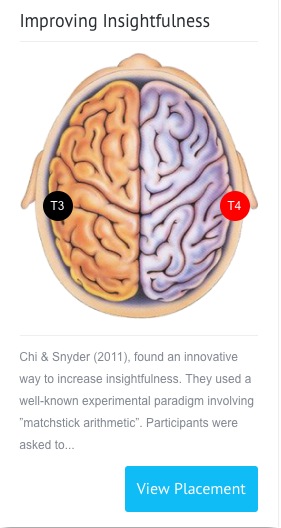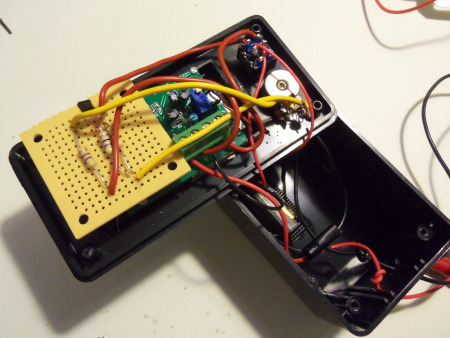
Steve Hockenyos is demonstrating a montage he got from tDCSplacements.com which purports to Improve Insightfulness (Cathode T3, Anode T4). The ‘BraiNet Placement Cap’ Steve is using can be found at bio-medical.com. (For comparison, have a look at Soterix’s, ‘Easy Strap‘.) Hoping Steve continues this video tDCS journal! [Update: 1/11/15 Steve seems to be doing this daily. He’s not said yet whether his experiment is producing results.]
Tag Archives: Allan Snyder
Weekend tDCS Insights – Chi & Snyder, SpeakWisdom, Carlo Miniussi
Some very excellent tDCS-related documents came to my attention over the weekend. I’m pretty sure I’d looked for at least one of them before, but that it was behind a paywall. I’ll provide links to the pdfs here, but suggest that (as has happened elsewhere on the blog) pdf links frequently go bad so ‘get em while they’re hot’.
Brain stimulation enables the solution of an inherently difficult problem (pdf)
This is the paper by Alan Snyder and Richard Chi that is frequently referenced in ‘unlock your inner savant’ articles on various pop-sci sites. (See also) Spoiler alert! Gives the answer to the ‘9 dot’ problem and once you’ve seen it it will be impossible to discover how ‘savant-like’ you are (at least according to this test).
…we applied cathodal tDCS (1.6mA) at the left anterior temporal lobe (ATL) together with anodal tDCS at the right ATL for approximately 10 min… None of the 22 participants in the main experiment solved the nine-dot problem before stimulation. But with 10 min of right lat- eralizing transcranial direct current stimulation (tDCS), we found that more than 40% of participants could do so.
 Dr. Brent Williams, at his SpeakWisdom blog, published another excellent tDCS post updating his DIY device, and adding a .doc that outlines his recommended (For Discussion) protocols for depression, ‘Savant Learning’, memorization, and chronic pain.
Dr. Brent Williams, at his SpeakWisdom blog, published another excellent tDCS post updating his DIY device, and adding a .doc that outlines his recommended (For Discussion) protocols for depression, ‘Savant Learning’, memorization, and chronic pain.
His protocol describes directions for use with either his ‘User-Built tDCS Research Device’, or the ActivaDose II.
Transcranial Magnetic and Electric Stimulation in Perception and Cognition Research (pdf)
This is a fascinating paper (Carlo Miniussi et al) that brings us up to date (2012) on applications of tDCS, TMS tACS (transcranial alternating current), and tRNS (transcranial random noise stimulation), especially in relation to cognition and learning. What really caught my eye was this entry about tRNS…
tRNS consists of the application of a random electrical oscillation spectrum over the cortex. tRNS can be applied at different frequency band ranges over the entire spectrum from 0.1 to 640 Hz…They applied tRNS to the visual cortices of healthy subjects and observed a significant improvement in the performance of healthy subjects in a visual perceptual learning task. This improvement was significantly higher than the improvement obtained with anodal tDCS…
And that folks, is how a weekend disappears down the rabbit hole!
